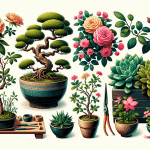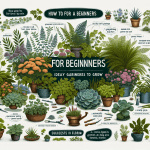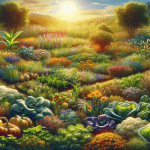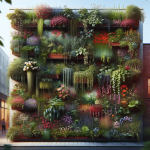This post may contain affiliate links. As an Amazon Associate, we may earn commissions from qualifying purchases.
Do you ever find yourself gazing out at your backyard, wondering if there’s more to it than just an open green space? It’s satisfying to imagine transforming your garden into a vibrant sanctuary for urban wildlife. You might be asking, how do I design a garden that supports urban wildlife while maintaining a bit of civility and order? Well, dear reader, that’s precisely what we’re going to unravel together.
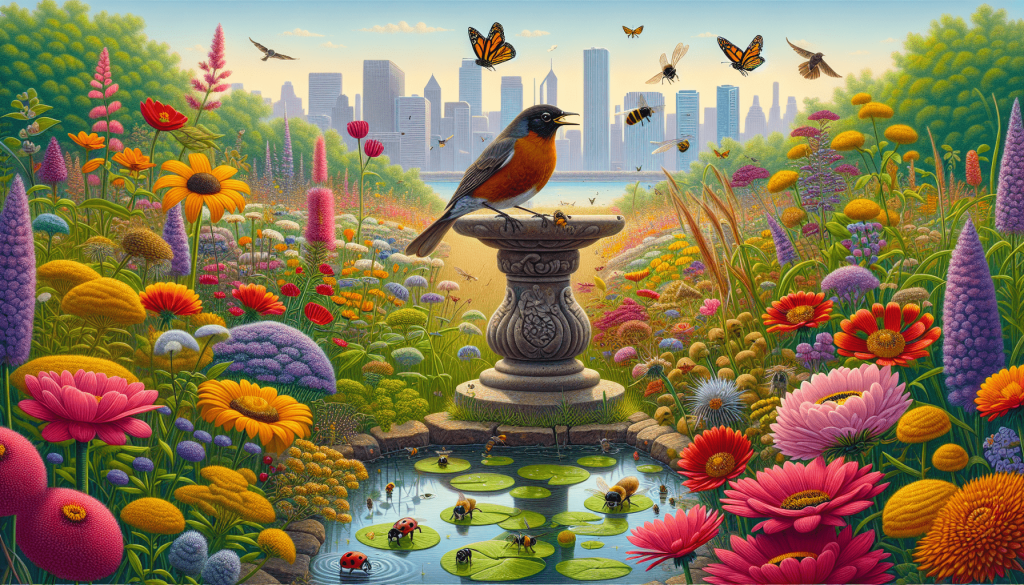
Understanding the Importance of Urban Wildlife Gardens
Before we get our hands dirty with soil and seeds, it’s vital to understand why one should care about fostering urban wildlife. In a bustling city landscape dominated by brick, steel, and glass, gardens play a crucial role as havens for native species that might find it challenging to survive otherwise. Yet, these green patches are often overlooked as mere spaces of beauty meant for the homo sapiens’ enjoyment. They are, however, so much more—microcosms that support biodiversity, offer food and shelter to various creatures, and help counteract pollution and heat.
When you create a garden that nurtures urban wildlife, you’re not just planting flowers—you’re actively participating in an ecosystem, supporting birds, bees, butterflies, frogs, and small mammals. These inhabitants can offer their delightful presence, facilitate pollination, and help control pests without the need for chemical interventions.
Planning Your Wildlife-Friendly Garden
Creating a welcoming habitat for wildlife doesn’t have to be overwhelming. Like any good recipe, it requires a thoughtfully collected assortment of ingredients. Let’s explore how you can plan a space that’s serene for you and inviting for fauna.
Assessing Your Site: Location and Layout
Start by examining your garden’s current layout. Observe the sunlight pattern—do some parts bathe in sunlight all day, while others are cool and shady? Note which areas are windy and which are sheltered. These observations will help you understand which plants and features will thrive best.
Consider creating zones within your garden to cater to a variety of creatures. Birds, for example, will appreciate trees and shrubs to perch on, while butterflies may be more drawn to open, sunny areas with a rainbow of flowering plants.
Setting Realistic Goals
Be honest about the time, energy, and resources you’re willing to invest. Do you envision a wilderness teeming with life or merely wish to attract a few more bees and butterflies? Each goal will dictate different approaches.
Your space will also influence your possibilities. A small balcony garden calls for container planting, while a larger backyard allows for mingling hedges, trees, and wildflower meadows. Rest assured, both offerings cater to wildlife if thoughtfully designed.
Essential Elements of a Wildlife Garden
Creating an urban oasis isn’t only about the flora. It’s about crafting an inviting and sustaining environment for various species. Let’s take a look at key components that bring life and diversity into your garden.
Native Plants: The Backbone of Biodiversity
Native plants are those that naturally occur in your region and have evolved alongside local wildlife. They are often more robust, require less maintenance, and are perfectly suited to local climate and soil conditions. By selecting an array of native species, you’re providing food and shelter tailored for the native fauna.
Consider planting a mix of trees, shrubs, perennials, and ground cover. Different structures and heights offer various habitats, from nesting sites to protection from predators. Aim for a diverse palette to support a wide range of creatures and year-round interest.
Water Features: A Refreshing Necessity
Water is essential for life. Even a small water source can transform your garden into a wildlife hub. A simple birdbath provides much-needed refreshment and is a delight to witness. Options range from large ponds to small fountains, but all require some care to avoid becoming mosquito nurseries.
Position your water feature thoughtfully—shaded enough to prevent evaporation, yet open enough for birds to spot predators while they bathe. Adding aquatic plants can further encourage biodiversity.
Shelter: A Safe Haven
Safety and privacy are key for wildlife feeling at home. Provide shelter in the form of hedges, rock piles, logs, or even man-made installations like birdhouses and insect hotels. These offer refuge from weather and predators and serve as essential breeding grounds.
You might craft a ‘wild corner’—a place where you allow nature to take its woody, leafy course. This undisturbed section is crucial for creatures that require less manicured habitats.
Attracting Beneficial Insects and Pollinators
Not all beetles are bad, and not every bug a bother. Some are invaluable allies, pollinating plants or predating on pests that can ravage your garden. Recognizing and encouraging these beneficial insects can make your garden thrive.
Bees and Butterflies: The Pollinators
To attract these essential pollinators, plant a variety of flowers that bloom across different seasons. Bees are drawn to blue, purple, and yellow blooms, with a preference for flat or shallow blossoms where they can easily collect nectar and pollen.
Butterflies, with their delicate admiration for color, seem to enjoy the same palette with added touches of pink and white. They appreciate sunny spots and nectar-rich flowers.
Ensure there’s food for larvae, as well. Butterfly caterpillars need specific host plants. For instance, milkweed is crucial for monarchs, while fennel and dill are favorites of swallowtail butterflies.
Predators in Disguise: Ladybugs and Lacewings
Not all insects plan to invade your vegetable patch. Ladybugs, for instance, feast on aphids—a gardener’s arch-nemesis—while lacewing larvae serve as natural pest controllers, dining on aphids, mealybugs, and mites.
Encourage these insects by avoiding chemical pesticides. Instead, foster a healthy plant environment and plant herbs like dill and fennel, which are naturally appealing to beneficial bugs.
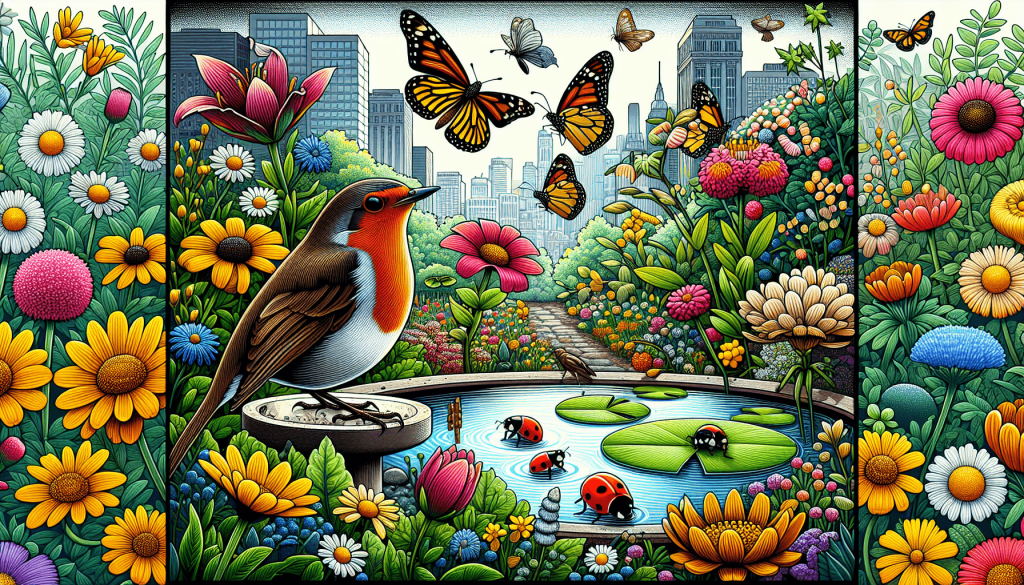
Creating Year-Round Appeal and Habitats
When designing your garden, think about how it will look and function in different seasons. A wildlife garden should not be a fleeting spectacle.
Flowering and Fruiting Through Seasons
Select plants that bloom and bear fruit across the spectrum of seasons. This ensures a consistent food supply for wildlife and a stunning garden for you to enjoy.
In the spring, daffodils and blooming fruit trees start the show. Come summer, sunflowers, and lavender join in. Fall welcomes asters and goldenrod, while winter showcases the resilience of holly berries and hellebores.
Managing Leaf Litter and Deadwood
The traditional instinct is often to clean up every fallen leaf or broken branch. However, deadwood and leaf litter are ecological treasures. They provide habitats, food, and nesting materials. A log pile can support beetles and fungi, while decomposing leaves create a rich bed for ground-dwelling insects.
Balance is key; resist the urge to over-tidy while keeping paths clear and maintaining a welcoming space.
Addressing Urban Challenges
Urban wildlife gardens face unique challenges. But fear not: with some clever strategies, they are surmountable.
Handling Urban Pollution
Plants such as bamboo, geranium, and honeysuckle are known for their air-purifying properties. They absorb pollutants and can buffer your sacred space against city grime.
Trees also play a significant role in reducing noise and air pollution. Consider planting birch or cherry trees which are not only visually appealing but also resilient purifiers.
Overcoming Limited Space
Limited space shouldn’t limit your ambition. Vertical gardening can maximize planting areas while providing habitats at various heights. Use trellises and hanging pots to keep things dynamic—ideal for people living in urban settings.
Remember, small changes can have big impacts. Even a single balcony pot with native flowers can support pollinators.
Contributing to Urban Biodiversity
By now, you’re equipped with the basics to design a garden that supports urban wildlife. Every sapling and seed holds the potential to nourish and sustain life within city bounds.
Community Efforts
Join community garden projects or collaborate with neighbors to create connected corridors for wildlife. These extended spaces allow for the safe passage of animals and expand habitat opportunities.
Citizen Science
Consider participating in citizen science projects that track local wildlife. This involvement not only aids broader conservation efforts but enriches your understanding of the creatures that enliven your garden.
Educating Others
Lastly, share your knowledge with friends, family, and neighbors. Inspire them to join you in their quests to support urban ecosystems. After all, change often begins with a conversation.
Embrace the Journey
Designing a garden that supports urban wildlife is an evolving adventure, one that calls for patience, observation, and a bit of whimsy. You’ll witness the seasons slipping and sliding over the landscape, see your efforts come alive with chirps and buzzes, and perhaps even watch a once-crowded city block transform into a luscious mosaic of life.
Take pride in each new visitor that finds sanctuary in your haven. Each day, let your garden be a reminder of nature’s resilience and your role in its enduring legacy.


